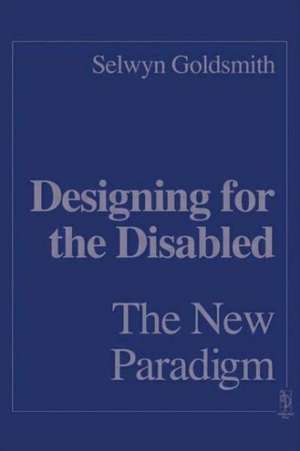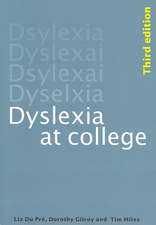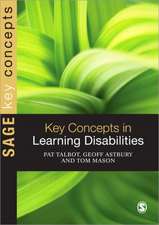Designing for the Disabled: The New Paradigm
Autor Selwyn Goldsmithen Limba Engleză Hardback – 13 noi 1997
Goldsmith's new paradigm is based on the concept of architectural disability. As a version of the social model of disability, it is not exclusively the property of physically disabled people. Others who are afflicted by it include women, since men customarily get proportionately four times as many amenities in public toilets as women - and women have to queue where men do not - and those with infants in pushchairs, because normal WC facilities are invariably too small to get a pushchair and infant into.
To counter architectural disability, Goldsmith's line is that the axiom for legislation action has to be 'access for everyone' - it should not just be 'access for the disabled', as it presently is with the Part M building regulation and relevant provisions of the 1995 Disability Discrimination Act. In a 40-page annex to his book he sets out the terms that a new-style Part M regulation and its Approved Document might take, one that would cover alterations to existing buildings as well as new buildings. But architects and building control officers need not, he says, wait for new a legislation to apply new practical procedures to meet the requirements of the current Part M regulation; they can, as he advises, act positively now.
This is a book which will oblige architects to rethink the methodology of designing for the disabled. It is a book that no practising architect, building control officer, local planning officer or access officer can afford to be without.
Preț: 521.04 lei
Preț vechi: 995.28 lei
-48% Nou
Puncte Express: 782
Preț estimativ în valută:
99.70€ • 104.36$ • 82.98£
99.70€ • 104.36$ • 82.98£
Carte tipărită la comandă
Livrare economică 24 martie-07 aprilie
Preluare comenzi: 021 569.72.76
Specificații
ISBN-13: 9780750634427
ISBN-10: 0750634421
Pagini: 442
Ilustrații: 1, black & white illustrations
Dimensiuni: 156 x 234 x 33 mm
Greutate: 0.98 kg
Ediția:1
Editura: Taylor & Francis
Colecția Routledge
Locul publicării:Oxford, United Kingdom
ISBN-10: 0750634421
Pagini: 442
Ilustrații: 1, black & white illustrations
Dimensiuni: 156 x 234 x 33 mm
Greutate: 0.98 kg
Ediția:1
Editura: Taylor & Francis
Colecția Routledge
Locul publicării:Oxford, United Kingdom
Public țintă
Professional ReferenceCuprins
(1) The evolution of accessibility controls; (2) Architectural disablement; (3) Britain: how accessibility controls might be reformulated; Annex A: The proposed Built Environment (Accessibility) Act: Draft Model for Authorized Guidance Document; Annex B: Housing; Appendices; References and Bibliography, Index.
Recenzii
'This New Paradigm is an intelligent, clear-sighted view of how we should approach access in our environment effectively rather than emotionally. It should be welcomed by architects.'
RIBA Journal
'The book is of great interest. Goldsmith's importance is undisputed in achieving recognition of the design requirements of the widest possible spectrum of human characteristics.'
The Architect's Journal
'Everyone concerned with the built environment should read this book.'
The Architectural Review
'Can any of us afford not to have Selwyn Goldsmith's New Paradigm on the shelf above our desk?'
Newsletter of the Access Officer's Association
'Goldsmith believes that in any new legislation the rule should not just be access for the disabled, but access for everyone. He is a master of selfless common sense.'
The London Magazine
'Architects should certainly read this book. They may as result come to adopt a richer and much more rewarding design approach.'
World Architecture
'An important new book.'
Building Engineer
'This is a fascinating book, not only for those who have a professional interest in building and design but also for anyone who has ever struggled with small children/buggies/shopping in public toilets or manoeuvred a wheelchair around the town.'
'The importance of this book reaches beyond what appears to be its immediate concerns, for in effect it denies the present but already fading trend towards factional politics. It argues for a rational approach to the question of how we should design for disabled citizens by asking the more crucial question, "who are disabled in trying to gain access to buildings?" It points out wisely that, physically disabled or not, we are all citizens. Being one people, we cannot afford to be in conflict with one another in destructive factional ways.'
ACCESS BY DESIGN
RIBA Journal
'The book is of great interest. Goldsmith's importance is undisputed in achieving recognition of the design requirements of the widest possible spectrum of human characteristics.'
The Architect's Journal
'Everyone concerned with the built environment should read this book.'
The Architectural Review
'Can any of us afford not to have Selwyn Goldsmith's New Paradigm on the shelf above our desk?'
Newsletter of the Access Officer's Association
'Goldsmith believes that in any new legislation the rule should not just be access for the disabled, but access for everyone. He is a master of selfless common sense.'
The London Magazine
'Architects should certainly read this book. They may as result come to adopt a richer and much more rewarding design approach.'
World Architecture
'An important new book.'
Building Engineer
'This is a fascinating book, not only for those who have a professional interest in building and design but also for anyone who has ever struggled with small children/buggies/shopping in public toilets or manoeuvred a wheelchair around the town.'
'The importance of this book reaches beyond what appears to be its immediate concerns, for in effect it denies the present but already fading trend towards factional politics. It argues for a rational approach to the question of how we should design for disabled citizens by asking the more crucial question, "who are disabled in trying to gain access to buildings?" It points out wisely that, physically disabled or not, we are all citizens. Being one people, we cannot afford to be in conflict with one another in destructive factional ways.'
ACCESS BY DESIGN
Descriere
Selwyn Goldsmith's Designing for the Disabled has, since it was first published in 1963, been a bible for practising architects around the world. Now, as a new book with a radical new vision, comes his Designing for the Disabled: The New Paradigm.
Goldsmith's new paradigm is based on the concept of architectural disability. As a version of the social model of disability, it is not exclusively the property of physically disabled people. Others who are afflicted by it include women, since men customarily get proportionately four times as many amenities in public toilets as women - and women have to queue where men do not - and those with infants in pushchairs, because normal WC facilities are invariably too small to get a pushchair and infant into.
To counter architectural disability, Goldsmith's line is that the axiom for legislation action has to be 'access for everyone' - it should not just be 'access for the disabled', as it presently is with the Part M building regulation and relevant provisions of the 1995 Disability Discrimination Act. In a 40-page annex to his book he sets out the terms that a new-style Part M regulation and its Approved Document might take, one that would cover alterations to existing buildings as well as new buildings. But architects and building control officers need not, he says, wait for new a legislation to apply new practical procedures to meet the requirements of the current Part M regulation; they can, as he advises, act positively now.
This is a book which will oblige architects to rethink the methodology of designing for the disabled. It is a book that no practising architect, building control officer, local planning officer or access officer can afford to be without.
Goldsmith's new paradigm is based on the concept of architectural disability. As a version of the social model of disability, it is not exclusively the property of physically disabled people. Others who are afflicted by it include women, since men customarily get proportionately four times as many amenities in public toilets as women - and women have to queue where men do not - and those with infants in pushchairs, because normal WC facilities are invariably too small to get a pushchair and infant into.
To counter architectural disability, Goldsmith's line is that the axiom for legislation action has to be 'access for everyone' - it should not just be 'access for the disabled', as it presently is with the Part M building regulation and relevant provisions of the 1995 Disability Discrimination Act. In a 40-page annex to his book he sets out the terms that a new-style Part M regulation and its Approved Document might take, one that would cover alterations to existing buildings as well as new buildings. But architects and building control officers need not, he says, wait for new a legislation to apply new practical procedures to meet the requirements of the current Part M regulation; they can, as he advises, act positively now.
This is a book which will oblige architects to rethink the methodology of designing for the disabled. It is a book that no practising architect, building control officer, local planning officer or access officer can afford to be without.











